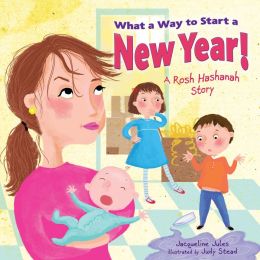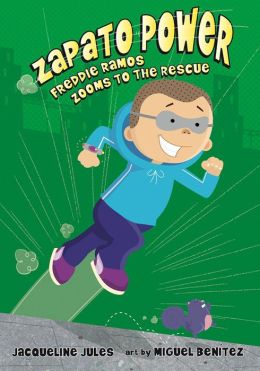Jacqueline Jules is an award winning author and poet. Among her many children’s titles are No English, Duck for Turkey Day, and Unite or Die, Sarah Laughs, and Benjamin and the Silver Goblet, all recognized by the Sydney Taylor Award, and Freddie Ramos Takes Off, a Bank Street College of Education Best Books of the Year.
Her latest book, What a Way to Start a New Year, is more than a Rosh Hashanah story. It explores a family’s move to a new town and starting over there—difficult at any time of the year, but especially so at holiday time. I recently spoke with Jacqueline about her writing.
You write an interesting mix of series fiction, picture books with a religious theme, & history.
I guess you could say I’m eclectic. It has to do with being a former school librarian, always dealing with a variety of topics and information, always finding things for my teachers and students. I collect information; I have a passion for it, even if it’s something I’m not particularly interested in. Many things fascinate me and I’m inspired by what I saw in schools, in the teachers and the kids.
You work ethnicity in your writing—Duck for Turkey Day, Freddie Ramos, and No English are multicultural titles.
The stories come from real life, from my experiences in my Title I school. No English is based on a girl who spoke no English. She would come into the library, shake her head, and say “No English.” I couldn’t write about if from my own experience of not speaking English, but I could write about it from the perspective of someone reaching out to be her friend. I loved having her start making friends while in the library!
Zapato Power is an easy chapter series. How did that come about?
The boys in school were always asking for books about superheroes. Most were longer texts and above their reading level, so Freddie was born! He is a mix of boys at my school: boys from military or one-parent families, boys in low income families, boys who are bilingual. Speed is important to boys, so I gave him the power of super speed. All kids have sneakers; Freddie’s are special. I’m pleased with how well the books have been received; they are showing up on Summer Reading Lists and lists of books supporting military families, including the Library of Congress’. A fifth Zapato Power book will be out next spring.
Your books are well received—several have won awards. Does being a librarian influence what or how you write?
Definitely, I was well versed in what was out there—or not out there! I knew what my students and teachers were looking for that they couldn’t find.
The joy of my job as school librarian was story time. I had to choose a book I liked; I was very picky about what I read aloud. It had to engage me; I needed to feel a connection to it. I like books with rich language because beautiful language leads to images. It was great training for being a writer. It made me want to create the very thing I love. When I write, I am cognizant of the interactive quality of the book. I love the storytelling tradition of repetition and work it into my writing. “Zoom Zoom Zapato” is an example of that. In my new book, “What a way to start a new year” is actually a refrain in the story.
Tell me a little about What a Way to Start a New Year. Did you start with story idea (new beginnings) or wanting to write a holiday story (Rosh Hashanah)?
It’s a story about a family who has just moved and one thing after another goes wrong. Being a holiday accents that.
It’s actually one of the first stories I wrote, maybe in 1989. It shows the power of persistence! It was sparked by the idea of moving just before a major holiday and it’s as much about the adjustment of moving as it is about the holiday. Being invited and welcomed by a family through the synagogue helps that adjustment. It wasn’t long enough for the chapter book I envisioned. I took it out and rewrote it every couple years.
Growing up, I lived in a small town. My father was on the look out at synagogue for new people; he would invite them to dinner and we’d have wonderful new friends. There’s something warm and welcoming about going to synagogue (or church). There is a familiarity with the songs and prayers, but the people aren’t the same. I took much of the story from my own memory, my life as a child and the way my parents were. It’s set in the synagogue I grew up in. I didn’t have to do much research for it—just the apple vs. honey cake, parts of the holiday meal.
Things tend to go wrong when you move, so I had the family be locked out, get a flat tire, spill juice—all everyday happenings that readers can relate to. We all adjust to new situations and circumstances. Rosh Hashanah tends to come at the beginning of the school year, so that adds a universal aspect to the book.
Is the book dedicated to your father?
No, I dedicated it to my mother! My father did the inviting, but it was my mother who was the gracious hostess and wonderful cook. Since the book ends with everyone enjoying dinner, I thought it should be dedicated to my Mom. In the Afternote, I mention my father’s habit.
Explore the difference between writing a religious themed picture book and your Zapato Power series. Is there any?
I like to entertain in my books; the Zapato Power books are funny, but there is some depth in the stories.
Many religious books only inform. My Bible storybooks are more serious than my other picture books. I used Midrash, Jewish parables, in telling the Bible stories, to flesh them out. I strove for words to evoke images and to bring emotional resonance to each story. I love to play with words. When I rewrite I try to say the same thing only better. It’s like the first drafts are in black and white, then I color in the detail and depth with words. It’s powerful and fun!












